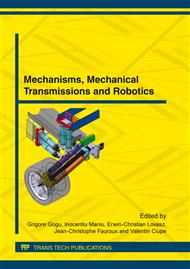p.224
p.234
p.242
p.252
p.258
p.266
p.276
p.286
p.294
Development of a Walking-Assistance Apparatus for Neuro-Rehabilitation
Abstract:
We have developed a prototype for a walking-assistance apparatus that serves as a next-generation vehicle or a movable neuro-rehabilitation training appliance for the elderly or motor palsy patients. Our prototype uses a novel spatial parallel link mechanism with a weight-bearing lift. Flat steps of the apparatus move in parallel with the ground; the apparatus supports the entire leg alignment (including soles of the feet) and assists walking behavior at the ankle, knee, and hip joints simultaneously. To estimate the walking phase of each leg of the equipped person, pressure sensors were attached under the thenar eminence and the heel of the sole and the pressure variation at each sensing point was measured. To determine the direction in which the equipped person is walking, a pressure sensor was attached to the flexible crural link. Motor palsy patients and those with muscle weakness can walk with the assistance of the apparatus. Patients who have ambulation difficulty can also use the apparatus with a weight-bearing lift that we developed. Using the apparatus with the weight-bearing lift prevents stumbling and enables input of walking movement to the brain motor area. The validity of the weight-bearing lift can be confirmed from the results of the measured %maximum voluntary contraction (MVC).
Info:
Periodical:
Pages:
258-265
Citation:
Online since:
March 2012
Keywords:
Price:
Сopyright:
© 2012 Trans Tech Publications Ltd. All Rights Reserved
Share:
Citation:


